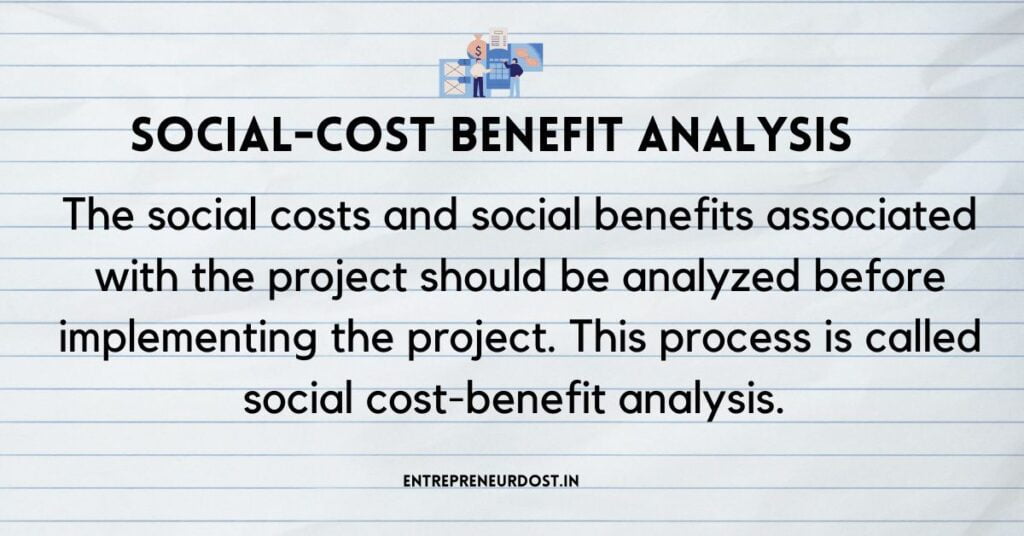Introduction
Today, in many societies, the community could be impacted as a result of projects that are of any size. Some projects may have positive results like the creation of job opportunities and economic development but they also bring negative effects like pollution, traffic jams, and so on.
Social Cost-Benefit Analysis (SCBA) is a useful instrument that enables us to see this complex picture using weighing the social implications of a project as a whole.
This blog post will move to the depths of an SCBA, by exploring what exactly it is and the main goal behind it, alongside the steps that are necessary to perform the analysis in full.
The second topic will explore the significance of SCBA and the various methods undertaken.
Finally, we will highlight the differences between the SCBA and the traditional financial analysis and also discuss practical problems encountered during the implementation of the SCBA.
Social Cost Benefit Analysis

All projects affect the community in some way. The impact may be positive or negative. If there are certain positive effects, there will be some negative effects also. For example, a project may give employment to many people. This is a positive (good) effect. As against this, there may be pollution, congestion, etc. This is a negative (bad) effect.
The positive effect on the society is called social benefit and the negative effect on the society is called social cost. If any activity leads to the depletion of a certain resource, it is called social cost. Before choosing which projects to go with, it’s super important to look at how they will affect society regarding costs and benefits.
Such an analysis is known as Social Cost-Benefit Analysis (SCBA). The theory of Cost Benefit Analysis can be traced to the 19th century when Jules Dupuit, a French Engineer in 1844 for the first time, set the welfare foundations. This cool paper is called “About How to Measure the Usefulness of Public Projects”.
Meaning of Social-Cost Benefit Analysis
Social cost-benefit analysis is based on the belief that a project is a resource investment proposition where not merely the entrepreneur but the nation as a whole gets involved.

Therefore, the project should also be looked at from the point of view of society or economy. This means the social costs and social benefits associated with the project should be analyzed before implementing the project. This process is called social cost-benefit analysis.
It is a project from the point of view of the total impact the project will have on the nation’s economy. In social cost-benefit analysis, we think about all the good things and bad things that happen to the whole society.
What is profit and loss account to an entrepreneur, that is a social cost-benefit analysis to society. In SCBA, we look at how a project affects society by considering the costs and benefits. This is true for projects funded by both private companies and the government.
But it is primarily used for evaluating public projects like roads, railways, bridges, transport, power projects, irrigation projects, etc. These projects have social implications. These may not have commercial benefits.
Thus, SCBA is the technique of evaluation of social benefits (project’s contribution towards overall growth and welfare of society) and social costs (project’s bad effects on society).
In short, social cost-benefit analysis is the appraisal of projects from a social point of view.
Social Costs and Social Benefits

A project is generally acceptable when the social benefits exceed the social costs. The excess of social benefits over social costs is called net economic benefits. In SCBA, we mostly think about costs and benefits that are not related to money.
The non-monetary social costs from a project are the bad effects caused by:
- pollution,
- congestion and crowd,
- wastes,
- monopoly and other malpractices,
- ecological imbalances due to over usage of resources,
- global warming, etc.
Similarly, non-monetary benefits from a project include the project’s contribution towards the increased welfare of society. These include:
- development of backward regions,
- increased employment,
- increased welfare of labor,
- balanced regional development,
- earning of foreign exchange,
- taxes,
- subsidies,
- usage of foreign exchange, etc.
Objectives of SCBA
The primary objective of SCBA is to secure and achieve the value of money in economic life by simply evaluating the costs and benefits of alternative economic choices and selecting an alternative that offers the largest net benefits.
The following are the important objectives of SCBA:
- Helping the economy grow by adding to the GDP through the project.
- Contributing to the project to improve the benefits to the poorer section of society and reducing the regional imbalance in growth and development.
- Contributing to the project to protect/improve the environmental conditions.
- Explaining why the project is worth using the limited resources of the economy.
Thus the ultimate objective of SCBA is to enhance contribution to society by the entrepreneurs.
Steps in SCBA (Mechanics of SCBA)
The simple steps that are used to make SCBA work are:
- Identification and estimation of costs and benefits which will accrue to the project implementing body.
- Identification and estimation of the costs and benefits that will accrue to individual members of society as consumers or as suppliers of factor inputs.
- Identification and estimation of the costs and benefits that will accrue to the community.
- Identification and estimation of the costs and benefits that will accrue to the national exchequer.
- Determination of a suitable discount rate (i.e., social discount rate).
- Discounting of the costs and benefits that accrue over some time to determine the present worth of projects.
- Selection of project(s) by using suitable investment criteria.
Significance / Importance of Social Cost-Benefit Analysis
The importance of Social Cost Benefit Analysis may be understood from the following points:
- There are non-monetary costs and non-monetary benefits associated with the project. These are hidden. These have an impact on the society or economy. Therefore, these should be considered for ascertaining the viability of the project. In SCBA, these social costs and benefits are considered.
- Market prices form the basis for computing the monetary costs and benefits from the point of view of the entrepreneur. These reflect social values only under conditions of perfect competition. But the conditions of perfect competition prevail very rarely in developing countries. When there are imperfections, market prices do not reflect social values. Hence, SCBA becomes important.
In SCBA, shadow prices are used for the valuation of inputs and outputs of goods and services because the market prices in many cases do not represent their real cost. Shadow prices reflect the economic or real value of inputs and outputs.
The market price of both inputs and outputs of a project should be corrected suitably if they do not represent the real prices of inputs/outputs. When the price of something is fixed, it is called the shadow price. In other words, shadow prices are economic prices in a perfect market.
- The division of benefits between consumption and savings leads to investment. This is relevant from a social point of view. In SCBA, it is believed that saving one rupee of benefits is more important than using one rupee of benefits. That’s why a higher value is given to it.
- Similarly, the redistribution of benefits is important from a social point of view. Helping poor people with money is seen as more important than helping rich people save money. This is also considered in SCBA. Thus, the real value of a project can be ascertained only after social cost-benefit analysis.
- SCBA is used for land reclamation, formation of towns, health and educational programs, research and development, defense projects, roads, railways, canals, airports, and other transport projects, water projects, etc.
- Nowadays, business enterprises are concerned about social responsibility. For such business enterprises, social cost-benefit analysis is a must.
Basic Approaches to SCBA
Mainly there are two approaches to SCBA. They are:
- UNIDO approach
- Little-Mirrlees approach.
UNIDO Approach (United Nations Industrial Development Organization):
This technique develops a less complex and less expensive SCBA. The UNIDO SCBAs provide for the situations in the developing countries and where the cost is an important factor. One of the features they shall be focusing on more is the ease of usage and sacrifice some of the advanced features found on others.
Little-Mirrlees Approach:
This method focuses on not only producing a fully-featured SCBA but also developing cutting-edge equipment with the ultimate goal of providing maximum safety and functionality. The terminology “Little-Mirrlees SCBAs” most often identifies gas masks utilized by professional firefighters and factory workers whose jobs can be more risky. They are more complex in use and maintenance, but they can provide a higher level of protection and capabilities.
| Feature | UNIDO Approach | Little-Mirrlees Approach |
|---|---|---|
| Focus | Affordability, Simplicity | Performance, Safety |
| Target Users | Developing countries, cost-sensitive situations | Professional firefighters, industrial workers |
| Complexity | Lower | Higher |
| Features | Basic | Advanced |
Difference between Financial Analysis and SCBA
In financial analysis, only financial costs and benefits are considered for the appraisal of a project. Financial analysis aims to determine the financial viability. Social impact is ignored in financial analysis. But in SCBA, not only financial costs and benefits but also social costs and benefits are considered.
Financial analysis uses mainly market prices for the computation of costs and benefits. However, SCBA uses shadow prices for the computation of social costs and benefits.
Financial analysis is undertaken to attain financial objectives such as maximization of owner’s wealth, sales maximization, etc. But SCBA is carried out to achieve certain social objectives such as the development of backward areas, employment generation, foreign exchange earning, etc.
The financial analysis ignores externalities. But SCBA takes into consideration, the externalities. It determines the worth of the project from society’s point of view.
| Financial Analysis | Social Cost-Benefit Analysis |
|---|---|
| Considers only financial costs and benefits | Considers both financial and social costs and benefits |
| Uses market prices for calculations | Uses shadow prices for social costs and benefits |
| Focuses on financial objectives (profit maximization) | Focuses on social objectives (development, employment) |
| Ignores externalities | Considers externalities (impact on society) |
Practical Problems and Limitations of SCBA
There are a variety of problems and limitations in SCBA. Some of them may be discussed
- Basic assumptions: SCBA assumes a market economy and full employment. But these do not prevail in developing countries. Thus, assumptions of perfect market conditions do not apply to these countries. Due to market imperfection, in developing countries, market prices do not reflect social values or real values.
- Govt. policy: The govt. in developing countries uses tariff policy to promote exports and restrict imports. This tends to raise the domestic prices. Protection of home products also tends to raise their prices. Taxation policy also may raise domestic prices. Subsidies, on the other hand, are used to keep the prices down.
- Linkages and externalities: Setting up a new project may at times produce reaction and change in related economic activities. These linkage effects can be negative as well as positive. The negative linkage effects create social costs, while positive linkage effects generate new economic activity and additional benefits. A deep analysis of such externalities is not possible. It is difficult to quantify and determine the monetary values of non-monetary social costs and benefits.
- The cost of CBA: The cost of cost-benefit analysis at times may not justify any such exercise, particularly in the case of small projects. It is difficult to say clearly what the optimal size of a project for which CBA should be undertaken. This can be done according to the principle that maximum net benefit arises when the MC = MB (Marginal Benefit). But in real life, it is difficult to establish any such relationship.
- Depth of analysis: It is difficult to state how elaborate or restricted the cost-benefit analysis should be. Any such decision depends upon the perception of the management.
Types of Costs in SCBA:
- Direct Costs: They are the actual costs of purchasing the equipment and keeping it in adjustment. They include:
- Capital Costs: The initial cost of the SCBA unit which includes the mask, air cylinder, harness and harness, and all accessories.
- Maintenance Costs: The recurring costs that are needed to maintain the SCBA system. This process involves frequent checks, cleaning, and mending the parts as they get damaged and newly manufactured ones if necessary.
- Training Costs: The amount of money necessitated by the training of personnel on the safe and reliable use of SCBA. This could take a form of traditional teaching, including various practical exercises, and periodic revision.
- Refilling Costs: The need to refill the air cylinder with fresh, breathable air becomes pricey.
- Indirect Costs: These are the costs unnoticed when using SCBA, but still they may play a role. They include:
- Reduced Productivity: While the process of SCBA itself consumes time, it hurts workers in terms of productivity, especially when it takes place numerous times.
- Physical Strain: Putting on an SCBA may be physically demanding, especially when it is worn over a longer period in a hot environment. Here it can be mentioned that this might result in increased risks of fatigue and possible injuries.
- Downtime: Should the SCBA fail, or need maintenance, one will be out of service, which can affect the operations.
- Intangible Costs: These are the more difficult to account for costs of SCBA utilization. They include:
- Psychological Stress: When operating in situations that require SCBA, it gets stressful, and the awareness of the dangers the environment holds.
- Reduced Morale: Moreover, the cumbersome nature of SCBA may not be agitable for most people to use which reduces the level of enjoyment associated with the work.
- Reputational Risk: Failures in using SCBA equipment can lead to serious life-threatening situations, and tarnishing the organization by damaging its image.
Types of Benefits in SCBA:
- Tangible Benefits: These are the tangible and quantifiable advantages to be derived from SCBA usage. They include:
- Improved Worker Safety: SCBA is a respiratory protection tool for hazardous environments that not only prevents illness, injury, or death but also is a disease prevention mechanism.
- Reduced Downtime: Protection of workers from hazardous substances is one of the functions that SCBA can do to keep the workers healthy and able to work and less likely to stay home due to illness.
- Compliance with Regulations: In a lot of occupations a SCBA is obligatory to ensure the timelines of safety codes.
- Intangible Benefits: These include the undesignable benefits that may be related to the use of SCBA.They include:
- Peace of Mind: Workers who know that they have registered respiratory protection at their workplaces can work more confidently.
- Improved Public Image: Organizations that make employee safety their focus, can partake in a positive public image and a good corporate reputation by deploying SCBA use.
- Enhanced Worker Morale: Workers feel more secure and safer when they know their well-being is appreciated. Therefore, the job satisfaction and the morale of the workers increase.
- Social Benefits: These are the advantages that not just organizations using SCBAs but also society in general stands to enjoy in its entirety. They include:
- Reduced Healthcare Costs: By preventing the workers’ injuries and illnesses occurrence, the SCBA contributes to lowering the overall healthcare costs.
- Environmental Protection: For some workers, SCBA can function as a means of protecting the environment by creating a cleaner environment.
- Improved Disaster Response: SCBA has a critical role in rescue operations where rescuers have to work in toxic areas and inhaling clean air becomes a primary concern for them.
Conclusion
Social Cost-Benefit Analysis presents a useful benchmark for project management and setting up the right policies. Through a balanced approach to social impacts, SCBA supports society and allows the projects to contribute to a more sustainable and just future. However, the problem of the non-monetary costs and benefits quantification is identified, SCBA still plays a major role in the selection of projects and their implementation.
FAQ
What is the preliminary purpose of Social Cost-Benefit Analysis?
The main function is to assess the possible costs and benefits attached to each of the possible options (economic alternatives) and choose the one that offers the highest social benefits to society.
Differing from the financial analysis, what is precisely Social Cost-Benefit Analysis?
Social Cost-Benefit Analysis consists of both financial and social costs and benefits, while financial analysis focuses solely on monetary aspects. Additionally, Social Cost-Benefit Analysis accounts for externalities and societal objectives, making it more comprehensive.
What are some practical challenges of Social Cost-Benefit Analysis as it pertains to users?
Along with these challenges include the presumes of market conditions perfectly, government policies that impact market prices, difficulty in evaluating non-financial social costs and benefits, and the cost and accompanying complexity










Thank you for the good writeup It in fact was a amusementaccount it Look advanced to more added agreeable from you!However, how could we communicate?
Thank you so much for the kind words! I’m glad you enjoyed the write-up. I’m always looking to improve, so I appreciate the encouragement.
I’m open to different communication channels. Would you prefer e-mail